Treat yourself to a bright and smooth cup of Japanese Iced Coffee at home. This method releases an array of complex flavors into the coffee that‘s flash-chilled to lock in the aroma and taste. Enjoy it right away or refrigerate it overnight for a delicious beverage on the go.
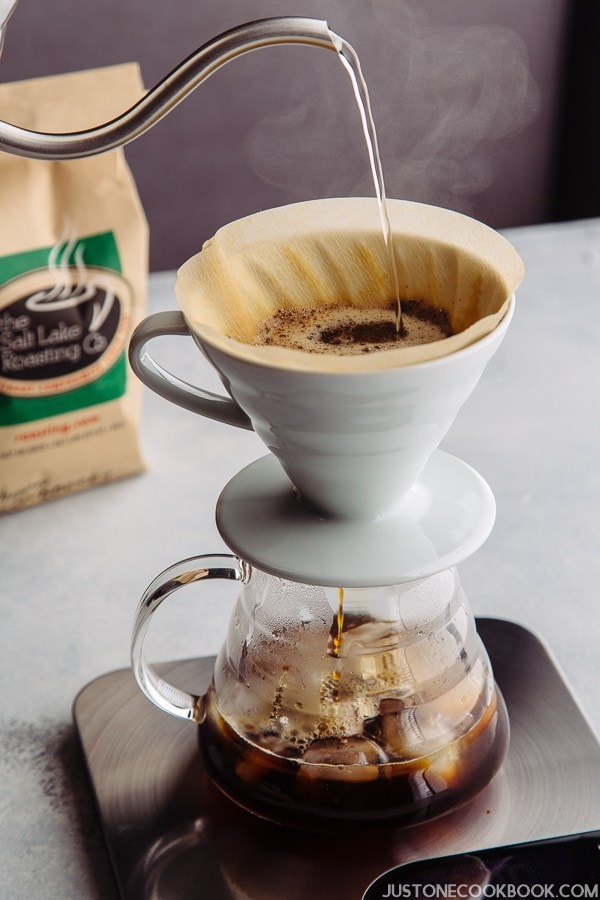
Every morning, the one thing I truly look forward to the most is the first sip of coffee. As Mr. JOC and I both enjoy coffee, we purchase and try different beans from local and independent coffee roasters, as well as coffee shops we visited when we travel.
As Cold Brew coffee got more popular in recent years, many coffee lovers seem to be more interested in how we make iced coffee in Japan, known as Japanese Iced Coffee. Today I’m sharing how the Japanese make iced coffee, which to us is “the best” way to enjoy coffee (until we find a better way).
What is Japanese Iced Coffee?
Japanese iced coffee is simply coffee brewed with hot water, directly onto ice. One-third of the liquid is in the form of ice and the other two-thirds in the form of pour-over.
What makes Japanese iced coffee different from just adding ice to hot coffee? As you pour the hot water over the coffee grounds, it extracts a wide range of tasty flavors and aromatics from the ground coffee. As it drops onto the ice cubes, the ice cubes instantly lock those flavors by flash-chilling at the same time diluting the concentrate.

Taste of Japanese Ice Coffee
To really test out this method, we tested both cold brew and Japanese iced coffee with multiple coffee beans. For each side-by-side comparison, the first thing we noticed was that Japanese iced coffee has much more flavors and aromatics. The subtle hints of caramel, chocolate, berries, and other delicious flavors hidden in the coffee beans are more pronounced with the Japanese iced coffee method for the same exact beans.
When done well, the Japanese iced coffee will result in a more flavorful, brighter, and complex iced coffee. You can also produce different results with the same coffee by adjusting the pour rate and grind size.
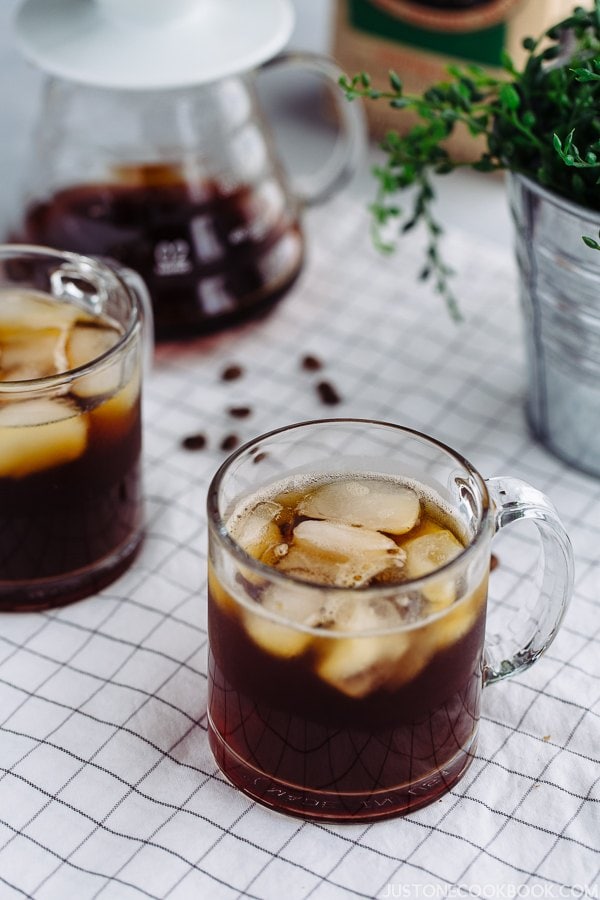
Pros and Cons of Japanese Iced Coffee
Pros:
- It makes cold coffee faster: it takes about 10 minutes including the time to boil water.
- The flavors are more robust than a cold brew.
Cons:
- It makes just one to two servings at a time.
- A little more labor-intensive than a cold brew and more work to make a big batch the night before.
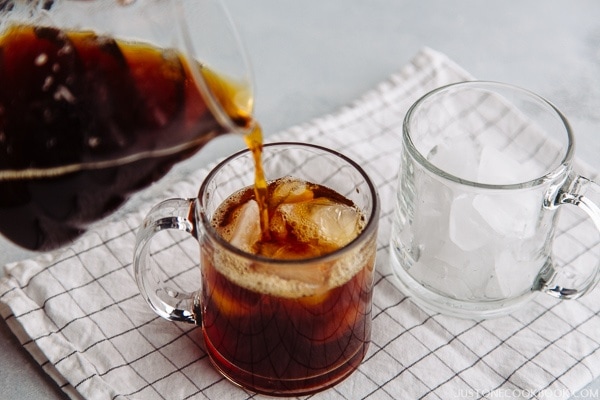
Equipment You Will Need for Japanese Iced Coffee
If you are already making hot coffee with a dripper, you will not need to buy special gear.
- Dripper (I use Hario V60 coffee dripper 02 ceramic)
- Server (I use Hario V60 range server 600)
- Drip kettle (I use Hario V60 drip kettle “Buono” 120)
- Paper filter (I use Hario V60 paper filter)
- Kitchen scale
- Note: As of Feb 2020, we switched to CHEMEX Pour-Over Glass Coffeemaker and coffee filters. The reason? It looks cooler and 1 less thing to wash as the dripper/server is one piece. The taste is the same!
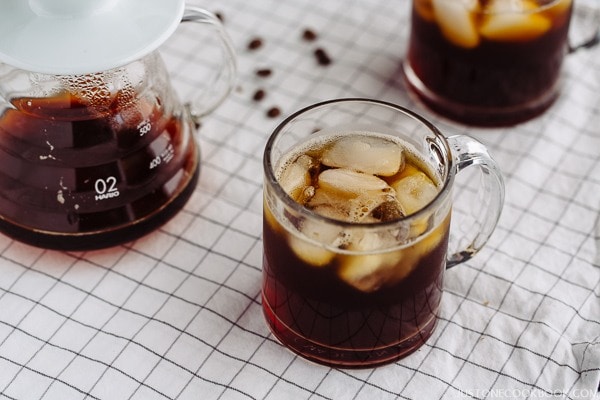
Coffee Beans that We Love
In conclusion, if you are a coffee lover and especially iced coffee, please give Japanese iced coffee a try. We recommend using delicate beans that are full of flavors. If you live in the bay area try the beans from Sightglass, Ritual, Four Barrel, or Blue Bottle.
Another bay area coffee roaster we highly recommend and offer truly extraordinary coffee beans is Helio Roast. It’s run by a former university professor named Kern Trembath. There are a few unique characteristics about Helio Roast:
- They use electric roaster powered by solar energy.
- They only roast the beans after you order them. You decide on the type of beans you want and roast level, and your coffee bean is handcrafted just for you.
There is nothing like freshly roasted coffee beans, the resulting coffee is simply excellent. Kern has generously offered all JOC readers 10% discount if you use the code “JUSTONECOOKBOOK” during checkout (we do not make any money from your order, we like to support small local businesses).
We’ve tried Sumatra Toba Batak, No Fear, and Sumatra Lintong Pak beans roasted at Full City+ level and they were amazing.
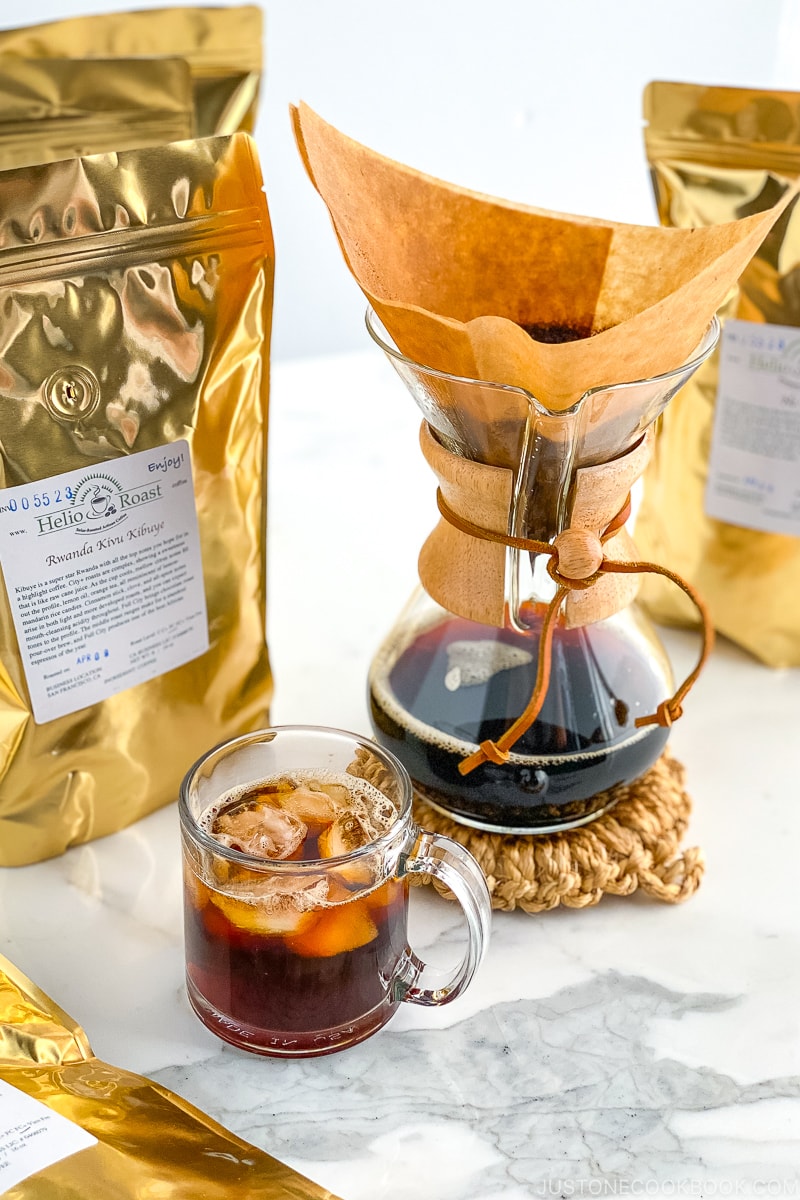
Lastly, if you travel to Salt Lake City, stop by and purchase some beans from John at the Salt Lake Roasting Co. John has an amazing selection of coffee beans from all over the world and we always stop by for some coffee and pastries when we go skiing in Utah. He also ships his delicious beans so you can purchase them online.
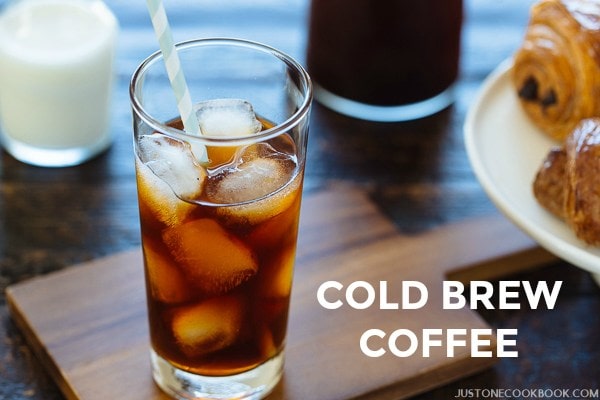
If you missed my Cold Brew recipe, please read here.

Wish to learn more about Japanese cooking? Sign up for our free newsletter to receive cooking tips & recipe updates! And stay in touch with me on Facebook, Pinterest, YouTube, and Instagram.
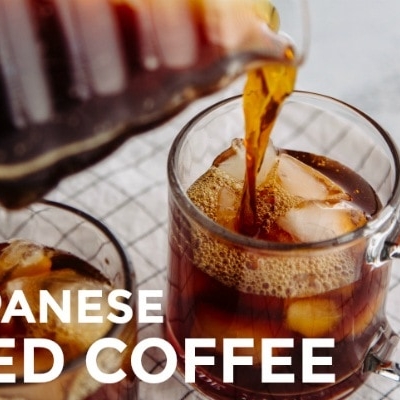
Japanese Iced Coffee
Video
Ingredients
- 30 g coffee beans (1 oz; weigh your beans, as 1 Tbsp is roughly 5 grams but it can vary depending on the beans; choose a light to medium roast for a bright flavor)
- 150 g ice (5.3 oz)
- 375 g hot water (12.7 oz; divided for the first and second pours; at 205ºF/96ºC; plus more to rinse the filter)
Instructions
- Start boiling plenty of water in a drip kettle. Once boiling, remove the kettle from the heat and allow the water to cool slightly to 205ºF/96ºC. In the meantime, prepare the rest of the steps below. Tip: Do not use boiling water (212ºF/100ºC) for your pour-over coffee; it will over-extract the flavor from the grounds and result in a bitter brew.

- Meanwhile, place a paper coffee filter in a coffee dripper set on top of a mug or cup. Pre-wet and rinse the filter with some hot water from the kettle. Let it drain, then dump out the water from the cup.

- In a coffee grinder, grind 30 g coffee beans (1 oz) to a medium or medium-fine grind size. I selected the Drip setting on my grinder.

- Set a pour-over server or carafe on a digital kitchen scale, then turn it on. Measure and add about 150 g ice (5.3 oz) to the server.

- Set the dripper on top of the server. Add all the ground coffee to the rinsed filter in the dripper. Level the grounds. Press the Tare button to reset the scale to zero.

- When the water in the drip kettle registers 205ºF/96ºC, slowly pour 125 g (4.2 oz) of hot water in a circular pattern around the cone of the dripper, fully wetting the grounds. Allow the coffee to steep and drip for 30 seconds. Then, slowly pour another 250 g (8.5 oz) of hot water onto the grounds in a circular pattern. Allow the coffee to steep and drip into the server. When finished, you should have about 500 ml (17 oz) of iced coffee.

To Serve
- Serve the Japanese Iced Coffee over additional ice in a glass and enjoy!

To Store
- Place the coffee in an airtight container and store it in the refrigerator for no longer than 1 day to preserve freshness and aroma.
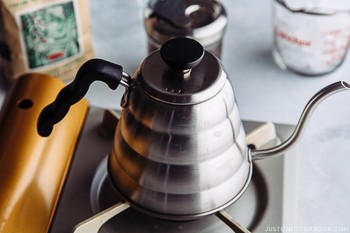
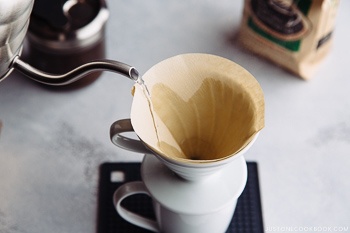
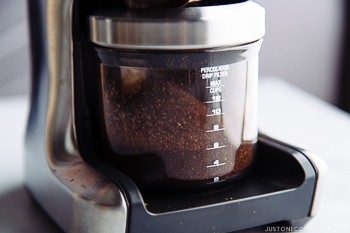

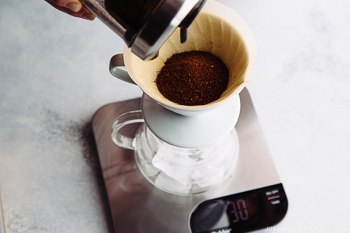
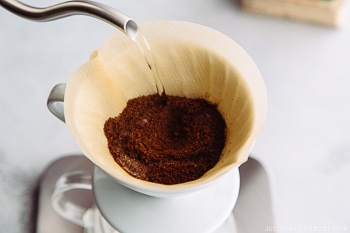

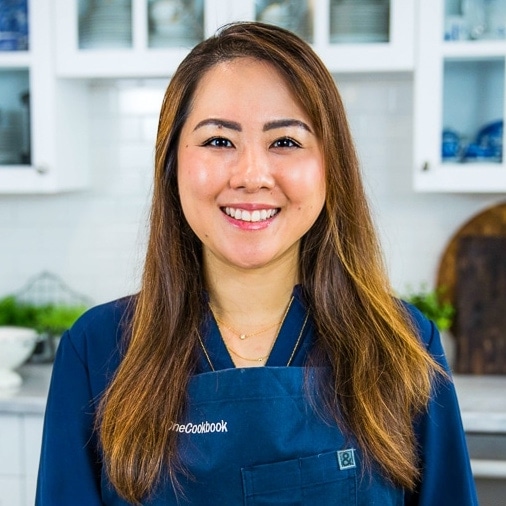
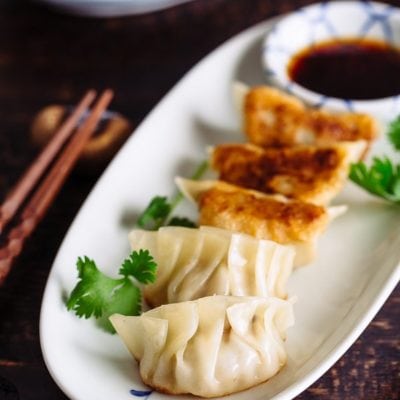
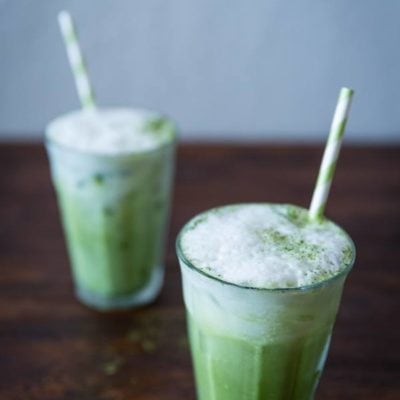
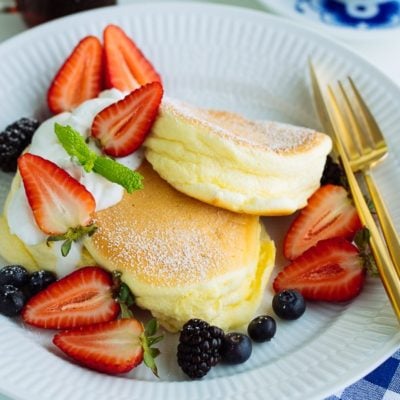
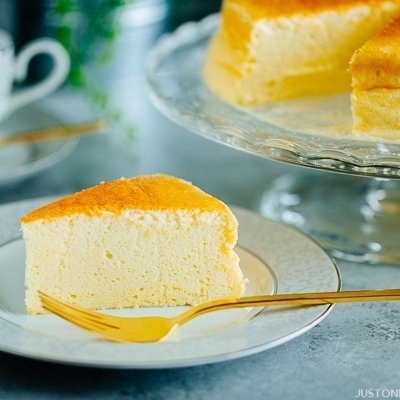
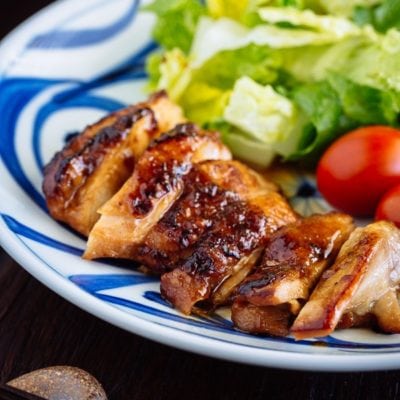
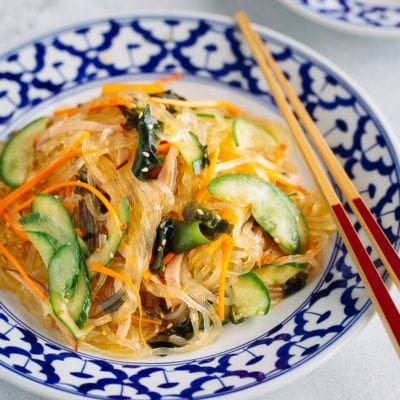
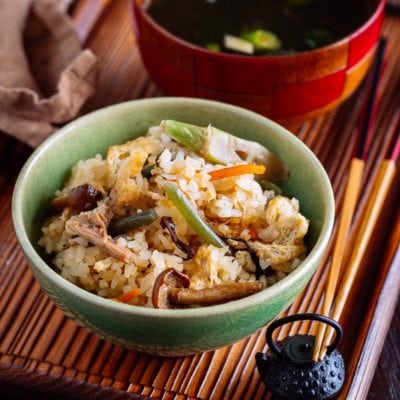
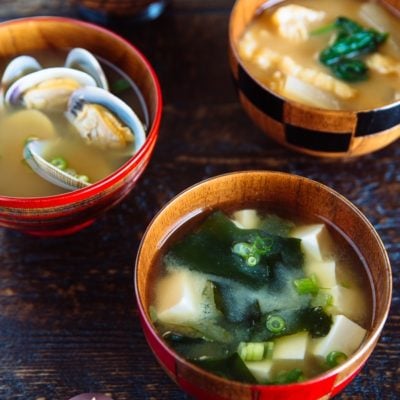
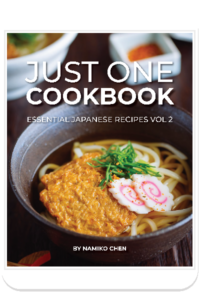
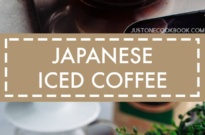
Hi Nami,
Thanks for the recipe! It’s getting hot here and I’ve been craving iced coffee. I tried a different recipe using 60% hot water – 40% ice, but I found it a bit too diluted. I’ll give yours a shot!
I definitely agree – cold brew is incredibly convenient and pretty foolproof, but this preparation of iced coffee is much more nuanced and preserves the complex flavors in good coffee.
I’m curious – was this always the way iced coffee was prepared when you grew up in Japan?
Also, I really like those drinking glasses you have pictured. Do you know the make and model of them?
Thanks!
Hi Jason! Hope you enjoy the recipe! Hmmm when I grew up in Japan… I wasn’t allowed to drink coffee (my mom was strict) until like high school or so, so I honestly don’t remember what was the trend then. My mom always drinks black hot coffee too. I wish I can tell more but I wasn’t a coffee person until I came to the US and started drinking espresso (and back then Starbucks didn’t even exist in Japan yet! Gosh I feel old). The glasses are from Cost Plus World Market, but I don’t see them at their online shop.
Would you be more specific on your recommendation for coffee. Brand name and type or name of specific type or brand
Hi Don,
Our favorite coffee is by Helio Roast, Sumatra Lintong Pak roasted at Full City +.
https://www.helioroast.com/p/sumatra-lintong-pak-organic
Helio Roast offer many beans and allow customers to choose their own roast levels! It’s absolutely fantastic and they don’t roast your beans until you place your order. There’s simply no comparison for how good their coffee is. They also give you a full pound of coffee vs. 12 oz from other roasters.
Hi Nami, Hope you are feeling well. I love how you write and explain everything. I must confess that I’ve not yet tried any since here the few Japanese ingredients I can find in the only Asian store are too expensive, and anyway, many of the items you mention are not available It would be great if I knew what substitutes I could use…if any. About the coffee, I am not a strong coffee lover. I love the aroma but don’t like the bitter taste. Which roast level would you recommend for a flavorful but not bitter coffee? I did read the explanations but it’s still Chinese to me….Lol…
Thank you for the great site and keep safe!
Hi Nany! I’m not sure where you live, but I understand it can be hard to find Japanese ingredients. Have two lists collecting online shops and local shops from local readers.
https://www.justonecookbook.com/japanese-grocery-stores-around-the-world/
https://www.justonecookbook.com/online-shops-for-asian-ingredients-goods/
As for coffee, you can try a light roast. It also matters where the beans are from etc… 🙂
I tried this coffee method and I am hooked! Added a little brown sugar and some salted cream on top, boy oh boy, was I in heaven! Thank you thank you thank you!
Hi Victoria! Oh that sounds delicious! I’m so glad you enjoyed the coffee! 🙂
This iced coffee is incredible! When I studied abroad in Japan, I developed a habit of drinking iced coffee at a particular cafe multiple times a week while I studied. I thought I would never experience the same taste where I live in America without buying a lot of expensive equipment, but this recipe produced the taste I remember from Japan on my first try, and the equipment investment was very reasonable. Rather than the Hario ceramic dripper or the Chemex combined dripper + server, I ended up going with a Hario dripper + server that’s very similar to the Chemex one. Thank you for sharing!
I have a question as well. My favorite cafe in my area, a Japanese-inspired cafe, serves a drink they call an “Okinawa brown sugar latte”. To my knowledge, it’s basically coffee (maybe drip coffee? I’m not sure because they use some kind of large machine to make the coffee) mixed with milk and a very thick, sweet brown sugar syrup. I’m not sure if it’s a drink that originated in Japan or not, but if you are familiar with it, do you think you might consider developing and posting a recipe?
Hi Kipp,
Thank you so much for your sweet comment. Japanese iced coffee is our daily drink as well as we love it. It’s the perfect balance between drip coffee and cold brew. Quality of the beans and water make the biggest difference and lately, we’ve been experimenting and mixing beans with different characteristic to create our own blend at home.
Okinawa brown sugar latte does exist in Japan and it’s made using Okinawa’s renowned black sugar. We’ll make a recipe for it!
[…] came across this method when reading about Japanese iced coffee. Hot brewing extracts all the acidity and flavors from the ground coffee. The freshly-brewed coffee […]
[…] I work from home, I usually take one for a mid-morning snack (after drinking Japanese Iced Coffee Mr. JOC makes every morning) to avoid snacking. Miso soup is so comforting and I hope you enjoy […]
I am just wondering, if decaf coffee could be used, as I have an allergy to caffeine.
Hi Kim! Yes, you can make with decaf and we make it at night after dinner. 🙂
Hi Laura! Haha, yeah Daiso has so many things, and stores are usually much bigger in Japan. Hard to leave the store with empty hands! 🙂
I’m going to try this!! I have been spring cleaning over the past couple of weeks, and I have a long list of food in the freezer and pantry to use up. One of those things is coffee beans! We haven’t been drinking much coffee at all lately; in fact, I only drink coffee a few times a year. But I do know I liked ice coffee when I was living in Japan, so I will definitely be giving this a try! 🙂
Hi Sarah! Hope you enjoy this recipe! I need to do spring cleaning too! 🙂
I’m sure I will, but sadly, right now, I only have a French press at home. So the enjoyment would have to wait until I have all the equipments needed.
Let me know what you think when you try. xoxo
I love iced coffee! I definitely need to try this. Thank you!
Hope you enjoy, Stacey! xo
Hi Nami, thanks for sharing this recipe. Based on my understanding of Japanese Iced Coffee method, I believe the method is to brew directly over ice so that as soon as the coffee drips from the v60, it instantly cools down to preserve the aroma and flavor.. I think this is the correct method rather than fully brewing the coffee into a carafe and then pouring it over ice as in your video. Here’s an example:
http://drinks.seriouseats.com/2011/07/how-to-make-japanese-style-iced-coffee-slideshow.html
Could you please verify?
Also, you mentioned that Japanese Iced coffee method is “without the acidity” but later in the article you mention that it is “brighter” which is confusing. That has been the opposite of my experience. With the Japanese iced coffee method, you are using a pour over like v60 which highlights acidity. Further, you are flash cooling the coffee which locks acidity in the coffee rather than allowing it to evaporate. I believe that if you want to reduce acidity, you would be better doing a cold brew. Just my two cents. Please let me know what you think. Thanks.
Hi Alex! That’s correct. I put ice cubes in my server (150-160 g) in Step 4 and in video… The ice cubes that rea in the serving cup is to keep the iced coffee cold (the iced coffee is already cold after preparing, and there are some remaining ice cubes in there but not much). If we want to keep the ice cubes bigger, some people use bigger ice cubes. We have the bigger ice cube tray, but we thought that’s another thing for people to buy, so we use regular ice cube size for this recipe. If you use bigger ice cubes, they retain the size of ice cubes better. With the filming and shooting at the same time, we probably spend extra time keeping the iced coffee standing, so ice cubes might have melt more than how we usually enjoy though. That’s what we noticed as we can tell from the videos that from the beggning, ice cubes are more round… Studio light and everything we can’t control the heat too well.
Anyway, I hope I answered to your question? I used ice cubes in the server so coffee drips over the ice cubes.
Regarding the acidity, Mr. JOC and I talked about this last night too. Technically it has more acidity than cold brew, but we were comparing the acidity level in regular coffee / regular ice coffee (not cold brew). Especially Mr. JOC has terrible acidity problem with the regular coffee, however he’s completely okay with Japanese iced coffee, so he wanted to include that in the post. 🙂
Thank you for your feedback, Alex!
Hi Nami, you’re right about the ice cubes! I missed that part, and apologies for that!
The acidity in coffee is a big problem for me too. It’s just that I just can’t see the logic why Japanese Iced Coffee would have less acidity than normal pour over coffee – after all, it is extracted in the normal pour over method which tends to filter out coffee oils and highlight acidity. The only difference is that it is instant cooled, which if anything, would lock the acidity in. Could it be that Japanese Iced Coffee doesn’t have less acid but that Mr. JOC simply tolerates iced coffee better than hot coffee in general?
Hi Alex, I can’t find any article that states how much acidity Japanese Iced Coffee method has, only found that cold brew has 60% less acidity than hot coffee. I might purchase a ph strip to test one day. For now, I can only rely on Mr. JOC’s stomach which is really sensitive to coffee acidity.
i really enjoy your recipes! Could you please convert the measurements for your recipe for Japanese iced coffee into American measurements? Mahalo!
Hi Kaimi! Thank you!
If you grind coffee beans into the same size as mine, 1 Tbsp is about 5 grams. If you grind to different size, the weight might vary, like 1 Tbsp matcha powder is 6 grams, just FYI.
There is no way I can measure ice cubes into cups…. But 340-350 g of hot water is 340-350 ml. 350 ml is 1 and 1/2 cup.
A kitchen scale is really good to have (mine is $10) for baking and a recipe like this… I always encourage my readers to have one. 😉
It would be very helpful to convert the ingredient i.e. Coffee, amounts from grams to cups for American readers. Thank you for your kind consideration. I enjoy your recipes.
Hi Yvonne! If you grind coffee beans into the same size as mine, 1 Tbsp is about 5 grams. If you grind to different size, the weight might vary, like 1 Tbsp matcha powder is 6 grams, just FYI.
There is no way I can measure ice cubes into cups…. But 340-350 g of hot water is 340-350 ml. 350 ml is 1 and 1/2 cup.
Sorry, a kitchen scale is really good to have (mine is $10) for baking and recipe like this… I always encourage my readers to have one. 😉